Thermometers: How to Take your Temperature
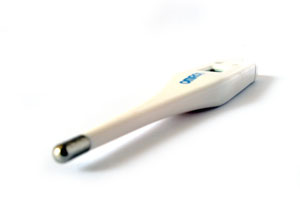
Why should I take my temperature?
Checking your body’s temperature with a thermometer is an easy way to see if a fever is present. A fever, which is a rise in the body’s temperature, is usually caused by an infection. Though fevers can be uncomfortable, they are a sign that the body is fighting off infection.
There are many different types of thermometers you can use to measure temperature. When using any kind of thermometer, make sure you read and follow the instructions that come with the thermometer. If your thermometer uses batteries, check them. You might notice that weak batteries give inconsistent readings.
What is a normal body temperature?
Normal body temperature is about 98.6 degrees Fahrenheit (°F) or 37 degrees Celsius (°C). Normal temperature often varies from 1° to 2°F (½° to 1°C). A normal temperature is usually lower in the morning and increases during the day. It reaches its high in the late afternoon or evening.
What temperature is considered a fever?
In adults, a fever is considered to be a temperature of 100.4°F (38°C) or above. You can treat this at home with a fever reducer medication and fluids to make yourself more comfortable, or let it run its course. But if it reaches 102°F (38.8°C) or higher and home treatment doesn’t lower it, call your healthcare provider.
What types of thermometer should I use to take a temperature?
Digital thermometer
A digital thermometer is the most accurate and quickest way to take a temperature. Digital thermometers are available in most drug stores and supermarket pharmacies. Depending on where you shop, a digital thermometer can cost from $6 to $20. Be sure to follow package instructions while using any thermometer.
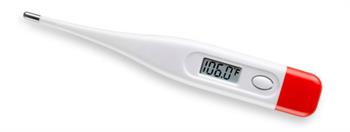
Digital thermometer
How to use a digital thermometer?
A digital thermometer can be used three different ways. These include:
- Oral: For this method, the thermometer is placed under the tongue. This method is used for adults and children 4 and over who are able to hold thermometer in mouth.
- Rectal: For this method, the thermometer is inserted gently into the rectum. This is mostly done in babies but can used in children up to 3 years of age. You can take rectal temperatures in children older than 3 years, but it might be difficult to keep them as still as they need to stay.
- Axillary: For this method, the thermometer is placed in the armpit for young children or adults whose temperature can’t safely be done orally. This method is not as accurate as oral or rectal but can be used as a quick first check. You can follow this with an oral or rectal reading.
Other types of thermometers (young children and adults):
Tympanic (ear): This type of thermometer measures the temperature inside of the ear by reading the infrared heat there. For best results, make sure to follow the instructions on the device about placing the tip correctly. For older babies and children, ear thermometers can be quicker and easier to use. However, they are not recommended if your baby is three months old or younger. They should not be used if your child has too much earwax, or if they have an earache.
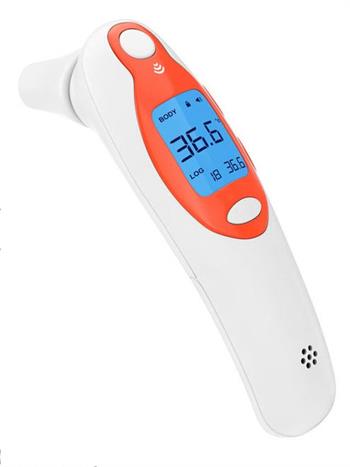
Ear (tympanic) thermometer
Temporal artery (forehead): Forehead thermometers are also used to measure temperature, but may not be as reliable as the digital thermometers and are usually more expensive. They are placed on the temporal artery of the forehead and measure the infrared heat that comes off of the head.
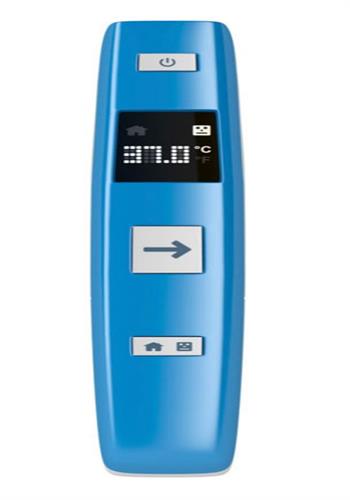
Forehead (temporal artery) thermometer
What types of thermometers aren’t recommended?
Some thermometers aren’t recommended due to their inaccuracy.
- Plastic strip thermometers only measure the skin temperature.
- Pacifier thermometers are not precise and are difficult to use correctly because they have to stay in the child’s mouth for long enough to record a temperature.
- Smartphone app thermometers.
Is my old mercury glass thermometer okay to use?
No, you should not use your old glass thermometer that contains mercury. These types of thermometers were found in nearly every house and hospital at one time before digital thermometers were available. The mercury thermometers were difficult to read and so did not always provide accurate information.
The main reason they are not longer recommended is that mercury can poison you. This can happen when the glass breaks and mercury is released. If you do still have one of these thermometers, you should contact your local waste department and find how to dispose of hazardous waste properly.
There are glass thermometers available that do not use mercury, but most people prefer the digital thermometers that do not shatter.
How do I take a temperature with a thermometer?
Using a digital oral thermometer
- Wash your hands with soap and warm water.
- Use a clean thermometer, one that has been washed in cold water, cleaned with rubbing alcohol, and then rinsed to remove the alcohol.
- Do not eat or drink anything for at least five minutes before you take your temperature because the temperature of the food or beverage could make the reading inaccurate. You should keep your mouth closed during this time.
- Place the thermometer tip under the tongue.
- Hold the thermometer in the same spot for about 40 seconds.
- Readings will continue to increase and the F (or C) symbol will flash during measurement.
- Usually, the thermometer will make a beeping noise when the final reading is done (usually about 30 seconds). If you are keeping track, record the temperature and the time.
- Rinse thermometer in cold water, clean it with alcohol and rinse again.
Using a digital rectal thermometer (for babies and children up to 3 years old)
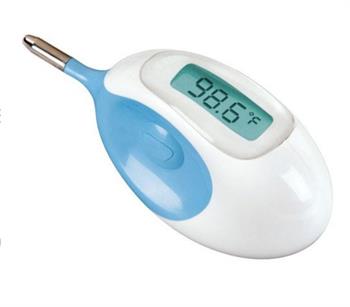 Rectal thermometer
Rectal thermometer
- Wash the rectal thermometer with soap and warm water. Don’t use an oral thermometer.
- Put a small amount of lubricant (petroleum jelly or Vaseline®) on the sensor (tip) of the thermometer.
- Place your child belly down on your lap or table, with one palm on their back. Or place them face-up, with legs bent toward their chest and hold the back of their thighs with one hand. Put a diaper or cloth under your child as he or she may poop immediately after removal of the thermometer.
- Using your other hand, gently insert the thermometer into the anus until the tip is completely inside the rectum. DO NOT force it if you feel resistance.
- Keep the thermometer steady with your hand until you hear the beep (around 30 seconds).
- Gently remove. Record temperature and time.
- Clean the thermometer thoroughly with soap and water. You may want to clean it off again with alcohol and then rinse it again.
Using a digital axillary (same as oral) thermometer
- Remove the child’s shirt and place the thermometer tip into your child’s armpit. Make sure your child’s armpit is dry to get the most accurate reading.
- Keep the axillary thermometer in place by folding your child’s arm across his or her chest.
- The thermometer will beep when reading is done (this method may take longer than 30 seconds).
- Remove and record temperature and time.
- Clean the thermometer with soap and water or with alcohol, always rinsing as a last step.
Should I add a degree to oral (under the tongue) and axillary (under the arm) readings?
Yes, for the most accuracy. Rectal temperatures are considered most accurate indication of the body’s temperature. Oral and axillary temperature readings are about ½° to 1°F (.3°C to .6°C) below rectal. Add these numbers to oral and axillary temperature readings for the most accurate reading.
Using a tympanic thermometer (for adults and children over 2 years old)
- Pull gently back on the top of the ear to open the ear canal.
- Place the protective cover on the tip of the thermometer.
- Gently insert the thermometer until the ear canal is fully sealed off.
- Press and hold down the button for 1-2 seconds until you hear a beep (follow the manufacturer’s instructions).
- Remove the thermometer, discard the cover, and record temperature and time.
Using a temporal artery thermometer
- Turn the thermometer on.
- Place the protective cap on the thermometer.
- Sweep the thermometer gently across the forehead so the infrared scanner can measure the temperature of the temporal artery.
- Record the temperature and time.
- Remove the protective cover and dispose of it.
Note: Some newer forehead thermometers do not require covers because the thermometer does not need to touch the forehead. These products are placed near the forehead and are able to take a reading.
How often should I take my temperature?
If you are feeling ill or if your child seems to be ill, it’s likely that you will reach for your thermometer. Often one of the first questions a health provider asks is if you have taken the temperature of the person who is ill. You may decide to take medicine to reduce the fever. If you do, there is usually a period of time on the instructions about when it is safe to take the medicine again. (This is usually a period of about four to six hours.) Before taking another dose, check your temperature or your child’s to see if medicine is really needed.
However, if the first temperature is very high, you might decide to recheck temperature on a more regular schedule, maybe once or twice an hour. You might decide to recheck temperatures when medicine doesn’t seem to be working, such as when the illness is not getting better, and you still have symptoms. Your healthcare provider might recommend times to take your temperature, like mornings and evenings. You should keep a record of these temperatures to be able to report back.
How should I clean and store my thermometer?
It is a good idea to keep the instructions that come with your thermometer so you can refer back to them for questions like this. Clean any thermometer before and after you use it. You can use soap and water or alcohol to clean the tips of digital thermometers. You should rinse afterward with lukewarm water.
If you are using one thermometer as a rectal thermometer, make sure to clean it thoroughly and label it. Store it in a way that you can tell immediately that it is the rectal and not the oral or axillary thermometer.
Check the directions, but ear and forehead tips may be swiped with alcohol. The bottom part, the handles, may be cleaned with tougher disinfectants. However, make sure you use water to wipe off the disinfectant so it does no damage to the handle or to your hands.
If your thermometer comes with a case to protect it, store your thermometer in the case.
Keep your thermometer (or thermometers) in a dry place that is easy to find and that is not exposed to drastic changes in temperatures.
When should I call my healthcare provider?
If you have questions about how to take a temperature, call your provider. They can give you tips on what’s the best type of thermometer for your family and the best way to take your temperature or your child’s temperature. This is a good time to ask things like how often you should recheck temperatures or if you should do anything to try to reduce the fever.
Call your healthcare provider right away if anyone in your household has a fever and any of the following:
- Severe headache.
- Stiff neck.
- Swelling of the throat.
- Confusion.
- Any change that worries you.
Remember, you and your healthcare provider act together to keep you and your family members healthy. They will be glad to answer questions about what thermometers are best, how they should be used and which numbers are important to keep track of. While a fever may be scary, it’s also trying to tell you something. Your provider is your partner in knowing what is being said and how to respond.




